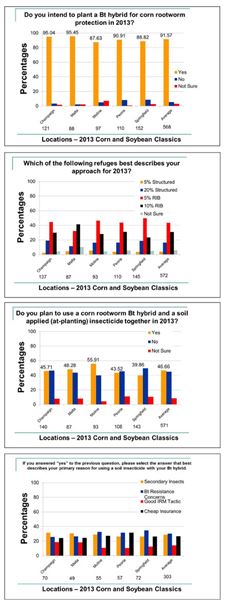Soil Insecticide Use On Bt Corn Expected To Increase This Spring Across Much Of Illinois
URBANA, ILL.
What a difference a year
can make. Many of us
will recall the record breaking
warm temperatures
of last March across the Corn
Belt of the United States.
Those temperatures fueled a
rush towards planting in April
and the earliest emergence of
western corn rootworm adults that I have witnessed.
On June 7, 2012, I reported that severe
rootworm injury had already occurred in a cornfield
located in Cass County along with plentiful
adults that were causing considerable injury to
the corn leaves. I don’t anticipate a similar early
emergence this season with snow still commonly
found in many fields across the northern
one-half of Illinois.
As I have done for many years, I used handheld
clickers (Turning Technologies) to poll producers
at the 2013 Corn and Soybean Classics
held in several Illinois locations in January.
Growers were asked if they intended to plant a
Bt hybrid for corn rootworm protection in 2013?
On average, for the five locations, nearly 92 percent
(n = 568 responses) of the producers indicated
that Bt hybrids would be targeted at corn
rootworms for the upcoming growing season
(Figure 1). The range in “yes” responses was
87.6 percent (Moline, n = 97 responses) to 95
percent (Champaign, n = 121 responses and
Malta, n = 88 responses). Not surprisingly, and
similar to previous growing seasons, the use Bt
hybrids will remain a key tactic used by producers
in 2013 for corn rootworm protection.

As more pyramided Bt hybrids enter the market
place, the type of refuge used will continue
to change in a very significant manner. In 2012,
the traditional 20 percent structured refuge was
still the dominant refuge approach used by producers
in the Corn Belt. Based upon responses
received at the 2013 Corn and Soybean Classics,
this refuge strategy will no longer remain
dominant for Illinois producers. Overall, the
most common refuge (Figure 2) that will be used
by producers who took part in these regional
meetings will be the 5 percent seed-blend
(refuge-in-a-bag) with 43 percent (n = 572 responses)
indicating they will be moving in this
new direction. The second most common refuge
tactic will be the 10 percent seed blend (refugein-
a-bag) with 31 percent relying upon this approach.
Together, these data indicate that
nearly 3 out of 4 producers who responded to
this question will use a seed-blend as their
refuge management strategy for corn rootworms.
The advantages of a refuge-in-a-bag
(RIB) are straightforward – convenience, ensured
compliance, and favorable from a resistant
management vantage point for western corn
rootworms (based upon emergence patterns and
inter-field dispersal dynamics of adults).In
2013, I anticipate a sharp increase in the use of
planting-time soil insecticides with corn rootworm
Bt hybrids. On average, nearly 47 percent
(n = 571 responses) of producers indicated they
intend to use both a soil applied (at-planting) insecticide
with their corn rootworm Bt hybrid
this spring (Figure 3). For the Moline meeting,
nearly 56 percent (n = 93 responses) of the producers
are likely to follow this strategy for 2013.
From my perspective, the escalation of soil insecticide
use along with corn rootworm Bt hybrids
has been fueled primarily over concerns
of Bt resistance and high commodity prices.
Producers who intend to use a soil insecticide
with their corn rootworm Bt hybrid this spring
offered several reasons for this approach (Figure
4). On average, concerns over secondary insect
infestations and Bt resistance were the top
issues cited for this practice. However, nearly
27 percent of the producers acknowledged that
they view the use of a soil insecticide with a corn
rootworm Bt hybrid as “cheap insurance.” Regarding
the potential insect resistance management
(IRM) benefits of a soil insecticide used in
combination with a Bt hybrid, more research is
warranted on this topic. In addition, I think it is
worth mentioning that one of the key benefits
touted concerning the use of Bt hybrids for corn
rootworm management was the reduction of soil
insecticide use. It is a bit surprising that 10
years after the first Bt hybrids entered the market
place for corn rootworms (2003), that a
heightened interest in the use of soil insecticides
has surfaced in such a significant fashion. Δ
DR. MICHAEL GRAY: Professor/Crop Sciences
Extension Coordinator & Assistant Dean for ANR
Extension Programs, University of Illinois